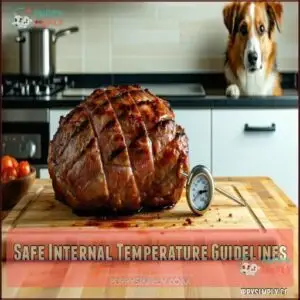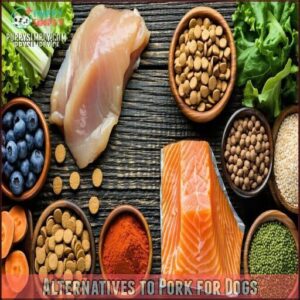This site is supported by our readers. We may earn a commission, at no cost to you, if you purchase through links.

Always serve plain, fully cooked pork without seasonings, sauces, or additives like garlic and onions, as these can be toxic.
Stick to lean cuts, avoiding fatty or processed options like bacon or ham, which can upset your dog’s stomach or lead to long-term health issues.
Raw or undercooked pork is a no-go—it may carry parasites like trichinella, which can cause serious complications.
Moderation is key, as too much pork can be tough on digestion. Choosing safe, well-cooked pork guarantees your pup enjoys it without the risks!
Table Of Contents
Key Takeaways
- Stick to plain pork and avoid any seasonings, sauces, raw pork, or bones to keep it safe for your dog.
- Opt for lean cuts like tenderloin, serve in moderation, and trim excess fat to avoid digestive and long-term health issues like pancreatitis.
- Watch for signs of allergies such as itching, vomiting, or swelling, and consult your vet if your dog shows any reactions after eating pork.
- Processed pork like bacon or ham is a no-go due to high fat and salt content; always prioritize unseasoned, simple pork options for treats.
Can Dogs Eat Pork
Yes, dogs can eat pork, but it’s important to prepare it correctly and feed it in moderation.
Pork can be a safe and tasty treat if it’s cooked thoroughly, unseasoned, and served in small portions.
Safe Pork Consumption Guidelines
When feeding dogs pork, keep it plain, fully cooked, and free of seasonings.
Moderation matters—treats shouldn’t exceed 10% of daily calories.
Opt for safe pork cuts like lean tenderloin or loin chops. For recommended pork products, consult online retailers.
Follow proper cooking temperatures to eliminate bacteria and parasites. Always remove bones to avoid choking hazards.
Safe, plain cooked pork can be a tasty, occasional treat.
Health Risks and Dangers of Pork
Raw pork carries the risk of the Trichinosis Parasite, like trichinella spiralis, causing vomiting and diarrhea.
Raw pork is risky for dogs—it can harbor parasites like Trichinella, leading to serious symptoms such as vomiting, diarrhea, and abdominal pain.
High fat increases Pancreatitis Risk, while brittle pork bones can lead to Bone Splintering or choking.
Toxic Seasonings like garlic or onion worsen pork toxicity for dogs, and some dogs may also experience pork-related allergic reactions.
These pork risks make unseasoned, cooked pork the only safe option for occasional, small portions, minimizing the risk of pork toxicity.
Pork Preparation and Cooking Guidelines
Cooking pork for dogs means paying attention to safety. Always cook pork to the USDA-recommended cooking temperature (145°F for roasts, 160°F for ground meats), removing bones to prevent choking.
To guarantee safety, consider using a meat thermometer to verify the internal temperature. Skip unsafe seasonings like garlic or onion.
Portion sizes should match your dog’s size, and supervise chewing to avoid pork risks. Proper pork preparation makes it safe and nutritious for dogs.
Is Pork Safe for Dogs
You might wonder if pork is safe for dogs after hearing mixed opinions.
The truth is, it depends on how it’s prepared and your dog’s specific needs.
Plain, cooked pork can fit into your dog’s diet occasionally, but it’s not without risks.
Over time, rich meats like pork can lead to digestive issues, especially for breeds with sensitive stomachs.
Always source lean cuts like loin or tenderloin to minimize fat content, and stick to small portions to avoid long-term effects like pancreatitis.
Proper pork preparation is key—fully cooked, unseasoned, and free of bones or additives.
It’s vital to cook pork to guarantee parasites are eliminated.
While pork benefits dogs in moderation, be cautious of pork risks dogs can face.
Always consider your pet’s unique sensitivities, and ensure that proper preparation is followed to minimize potential issues.
Risks of Feeding Pork
Feeding pork to your dog comes with potential risks, like allergies, harmful seasonings, and unsafe additives. Raw or undercooked pork also increases the chance of parasites and other health issues.
Raw or Undercooked Pork Risks
Undercooked pork isn’t worth the risk for your dog.
It can harbor parasites like trichinella, leading to trichinosis, or bacteria causing foodborne illnesses.
Trichinosis symptoms include vomiting, fever, and abdominal pain.
Without proper cooking temperatures, these dangers persist.
Always make certain pork is fully cooked to eliminate bacteria and parasite infections, keeping your furry friend safe from preventable health issues.
Seasonings and Additives Risks
Seasonings and condiments might make pork tastier for us, but they spell trouble for your dog.
Toxic ingredients like onion powder, garlic powder, and artificial sweeteners hide in many recipes. Harmful sauces, including barbecue, bring salt overload and sugar spikes.
Always double-check pork for hidden ingredients before feeding—it’s safer for your dog to stick with plain, cooked, unseasoned options.
Allergic Reactions and Sensitivities
If your dog shows itching, paw biting, or vomiting after eating pork, it could be experiencing an allergic reaction.
Pork allergies in dogs occur when their immune system overreacts to proteins, causing discomfort.
Sensitivity diagnosis often involves an elimination diet.
Long-term effects may include skin or digestive issues, consider alternative proteins to reduce food sensitivities and keep your dog healthy.
Benefits of Cooked Pork
Properly cooked pork can be a nutritious addition to your dog’s diet, offering protein and essential nutrients.
Stick to lean cuts and serve in moderation to keep it healthy and safe.
Nutritional Value of Cooked Pork
Cooked pork offers high protein content, delivering essential amino acids for muscle health.
Cooked pork is a protein powerhouse, providing essential amino acids to support strong muscles and boost your dog’s overall health.
It’s rich in pork vitamins like B6, B12, and thiamine, which boost energy and metabolism. Pork minerals, including selenium and zinc, support overall well-being.
Omega-3s and vitamin E promote skin and immune health.
However, raw pork carries risks, so cooking it thoroughly is important.
However, pork nutrition for dogs requires moderation due to its fat composition and calorie density.
Lean Cuts and Moderation
In terms of pork nutrition for dogs, choosing lean cuts like tenderloin or loin chops makes all the difference.
These lean meats fit perfectly into a balanced diet without overloading on fat.
Portion control is key—small servings as an occasional treat help maintain dog food moderation.
Remember, pork for dogs should complement their meals, not replace them.
Proper Cooking Methods
Ensuring pork is safe for dogs starts with proper preparation.
Always cook pork to safe temperatures—145°F for roasts, 160°F for ground cuts—and trim excess fat.
Avoiding seasonings is essential, as many are toxic.
Remove bones to prevent splintering risks.
Raw pork can carry trichinosis, so thorough cooking is essential.
Safe, cooked pork benefits dogs when prepared carefully, and proper handling is key to preventing risks like splintering and ensuring the pork is safe.
Safe Pork Options for Dogs
When choosing pork for your dog, it’s important to stick to plain, properly cooked options like pork chops or ground pork.
Always remove bones, excess fat, and seasonings to keep it safe and healthy.
Cooked Pork Chops and Ground Pork
A balanced approach makes pork chops and ground pork safe for your dog.
Chop preparation matters—trim fat and seasonings, then cook thoroughly. Ground pork benefits include easy digestibility when unseasoned.
Stick to safe portions, about 10% of daily calories, to avoid risks. Use simple recipes that complement your dog’s diet, ensuring cooked pork enhances their meals.
Pork Ribs and Bones Safety
Pork ribs aren’t safe for dogs due to bone splintering risks.
Cooked bones, in particular, become brittle and dangerous. Here’s what to know:
- Cooked rib safety: Always avoid serving cooked or uncooked bones.
- Sharp pieces: Splinters can cause choking or GI injuries.
- Safe alternatives: Use bone broth or smoked pork bones instead.
Alternative Protein Sources
If pork bones seem risky, there are plenty of protein options worth exploring.
Novel proteins like kangaroo or alligator, insect protein, and plant proteins offer safe alternatives. Fish, chicken, and protein supplements are also great choices.
Here’s a quick comparison:
| Option | Benefits | Considerations |
|---|---|---|
| Fish Alternatives | Omega-3s, lean protein | Mercury risk |
| Novel Proteins | Allergy-friendly | Availability varies |
| Plant Proteins | Fiber, low fat | Lower in amino acids |
Cooking Pork Correctly
When cooking pork for your dog, it’s vital to make certain it’s fully cooked to a safe internal temperature to eliminate harmful bacteria and parasites.
Following USDA guidelines, cook roasts to 145°F and ground pork to 160°F for your pet’s safety.
Safe Internal Temperature Guidelines
When serving pork to dogs, make sure it’s cooked thoroughly.
Ground pork should reach a minimum temperature of 160°F, while roasts need 145°F, according to USDA guidelines.
Use a meat thermometer for temperature monitoring to guarantee food safety.
Proper handling and cooking safeguard against bacteria, making the pork safe and healthy for your pup’s occasional treat.
Eliminating Bacteria and Parasites
It’s critical to cook pork thoroughly to reduce risks like trichinosis caused by Trichinella Spiralis or Salmonella infections.
Raw pork can harbor harmful bacteria and parasites, posing dangers to dogs.
Cooking temperatures should reach 145°F for roasts or 160°F for ground pork.
Safe handling and techniques like irradiation methods help guarantee pork is safe and parasite-free for your pet.
Some pet owners are now opting for gently cooked options to guarantee peak digestion.
USDA Guidelines for Pork Cooking
To keep pork safe for your dog, follow USDA cooking temperatures: whole cuts at 145°F with a 3-minute rest, ground pork at 160°F.
This eliminates harmful bacteria and parasites like Trichinella spiralis. Use a thermometer for accuracy, ensuring proper parasite elimination.
The USDA guidelines emphasize the importance of time-at-temperature for pathogen destruction.
Store cooked pork safely, avoiding cross-contamination. Dog safety starts with thorough cooking and careful handling of all cuts.
Pork Allergy Symptoms
If your dog has a pork allergy, they may show signs like itching, swelling, or digestive upset.
Recognizing these symptoms early can help you prevent discomfort and guarantee your dog stays healthy.
Signs of Allergic Reactions in Dogs
If you’re noticing changes like skin irritation or chronic ear infections after your dog eats pork, it might be a food allergy.
Symptoms of pork allergy in dogs can escalate quickly, so stay alert for signs:
- Facial swelling or difficulty breathing.
- Digestive issues like vomiting or diarrhea.
- Red, itchy patches on their skin.
Regular check-ups are always a smart move to ensure your dog’s health, especially if you suspect a pork allergy.
Digestive Upset and Long-term Effects
Over time, pork digestion in dogs can lead to digestive issues, like gastrointestinal upset or pancreatitis risks, especially with a high-fat diet.
Pancreatitis and kidney strain are serious concerns tied to excessive pork consumption.
Obesity concerns also arise from fatty cuts, potentially upsetting the gut microbiome.
Long-term effects include nutritional deficiencies if pork dominates the diet, impacting your dog’s overall health.
Diagnosis and Treatment of Pork Allergies
Identifying dog food allergies, like pork sensitivity, takes patience.
Allergy testing often involves elimination diets over weeks, isolating triggers.
If allergic reactions stop, pork’s likely the cause.
Symptom management includes adjusting dog diets, replacing pork with suitable proteins.
Long-term management requires veterinary care and strict dietary restrictions.
Always consult your vet for proper treatment and balanced dog food allergy solutions.
Alternatives to Pork for Dogs
If pork isn’t the best choice for your dog, there are plenty of other protein options to explore.
From chicken to fish and even plant-based alternatives, you can guarantee your dog gets a balanced and nutritious diet.
Other Protein Sources and Nutritional Profiles
For a well-rounded diet, consider chicken, beef, or turkey as alternative proteins.
Chicken nutrition offers lean protein, while beef benefits include iron and zinc.
Fish alternatives like salmon provide omega-3s for healthy coats.
Explore alternative meat options based on your dog’s needs.
Protein comparison guarantees balanced nutrition, so mix high-quality plant proteins or animal sources for variety.
Always consult your vet.
Plant-based Options for Dogs and Benefits
Switching from pork to plant-based protein? Dogs can thrive on vegetarian diets when done right.
Vegan dog food offers allergy management and grain-free benefits.
Mix these nutrient-packed options for a balanced diet:
- Quinoa and lentils for essential amino acids.
- Leafy greens for vitamins and fiber.
- Chickpeas for protein punch.
- Seaweed for iron.
- Grain-free dog food for sensitive stomachs, providing an alternative with grain-free benefits.
Comparing Nutritional Profiles and Making Choices
Choosing between pork, chicken, and beef for your dog’s diet depends on their needs.
Pork has a rich nutrient density but higher fat, while chicken is leaner.
Beef offers protein variety but may be heavier.
Lean pork options like tenderloin can balance a diet, but pork alternatives provide safer, diverse protein sources.
Focus on moderation and variety for a balanced meal.
Healthy Pork Consumption Tips
When feeding your dog pork, focus on quality and proper preparation to keep them healthy and safe.
Stick to lean cuts, cook thoroughly, and serve in moderation to avoid unnecessary risks.
Quality Control Measures for Pork and Dogs
Proper pork safety for dogs starts with quality sourcing and strict cooking standards.
Monitor additives carefully, as seasonings can harm pets. Thoroughly cook pork to prevent contamination, remove bones to avoid choking, and serve appropriate portions.
Excessive fat, however, can cause canine pancreatitis.
Food testing and lab safety guarantee dog food safety, while strict bone removal and serving size controls keep meals safe and enjoyable for pets.
Safe and Healthy Pork Consumption for Dogs
If canines eat pork, stick to lean pork cuts like tenderloin, cooked thoroughly to eliminate bacteria.
Pork preparation for dogs requires portioning appropriate to their size.
Gradual introduction prevents digestive upset, while vet consultation guarantees safety specific to your dog.
Pork nutrition for dogs can be beneficial if served plain and safe, making it a nutritious treat.
Moderation and Balance in Canine Diet
Feeding pork to your dog? Keep portion control in check! Pork has its place in a balanced diet, but too much fat can lead to pork risks for dogs, like pancreatitis.
Monitor calories, prioritize dietary diversity, and rotate proteins to guarantee balanced nutrition. Lean cuts in moderation help maintain a healthy dog diet.
Always consult your vet.
Frequently Asked Questions (FAQs)
Can dogs eat raw pork?
Picture serving sushi to your pup—it sounds fun, but raw pork is risky.
It may carry parasites like trichinella or bacteria like Salmonella, leading to serious illness.
Always cook pork thoroughly before sharing.
Can one eat pork?
Yes, you can eat pork as long as it’s thoroughly cooked to remove harmful bacteria.
Choose fresh cuts, avoid excessive fat, and season it to taste.
Handle and store it properly for safety.
Can dogs eat unseasoned pork?
Think of pork as a rare treat for your dog.
Unseasoned, fully cooked pork is safe in moderation, but avoid fat, raw meat, and bones.
Stick to lean cuts like tenderloin for healthier options.
Can dogs eat too much pork?
Too much pork can upset your dog’s stomach, cause weight gain, or even lead to pancreatitis due to its high fat content.
Stick to lean cuts, small portions, and treat it as an occasional snack.
Is it safe for dogs to eat processed pork?
Processed pork is like a double-edged sword—it’s tempting but risky.
High salt, fat, and additives in foods like bacon or ham can harm your dog, causing dehydration, pancreatitis, or even choking on bones.
Avoid it.
Is pork good for dogs?
Pork can be a tasty treat for dogs if it’s plain, properly cooked, and served in moderation.
Stick to lean cuts like tenderloin, remove bones and excess fat, and skip seasonings or sauces entirely.
Can a dog eat a pork bone?
Over 80% of pork bones splinter easily when cooked, making them dangerous for dogs.
They can cause choking or internal injuries.
Stick to safe, vet-approved chew toys or rawhide alternatives instead—it’s safer and smarter!
Can a dog eat pork ribs?
Dogs shouldn’t eat pork ribs.
The bones can splinter, causing choking or serious internal injuries.
Even without bones, rib meat is fatty, which might upset your dog’s stomach or lead to pancreatitis.
Stick to safer treats.
Can dogs eat bacon & ham?
Bacon and ham aren’t safe for dogs due to their high salt, fat, and additive content, which can harm digestion and cause pancreatitis.
Stick to plain, cooked, unseasoned meats to keep your dog healthy.
Can dogs eat bacon?
Bacon isn’t a great choice for dogs.
Its high fat and salt content can cause serious health issues, like pancreatitis or dehydration.
If your pup begs, stick to leaner, plain proteins in moderation instead.
Conclusion
Wondering if dogs can eat pork? The answer is yes, as long as it’s prepared safely.
Stick to plain, fully cooked, lean cuts to avoid harmful additives and excessive fat. Skip raw or undercooked pork to protect your dog from parasites and digestive issues.
Keep portions moderate, and watch for any signs of allergies or sensitivities. By following these guidelines, you can let your pup enjoy pork safely.
Always prioritize their health and balanced nutrition!
- https://pet-how.com/about-us/
- https://fdc.nal.usda.gov/fdc-app.html
- https://www.urmc.rochester.edu/encyclopedia/content.aspx?contenttypeid=76&contentid=07029-2
- https://raisedright.sjv.io/c/2442109/1223487/15124?u=https%3A%2F%2Fwww.raisedrightpets.com%2FDFA&subId3=canine-nutrition%2Fcan-d_amcid-pqFxNrm63s2NgIelYBNz7
- https://www.fsis.usda.gov/inspection/compliance-guidance


















